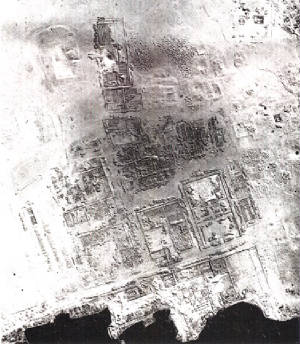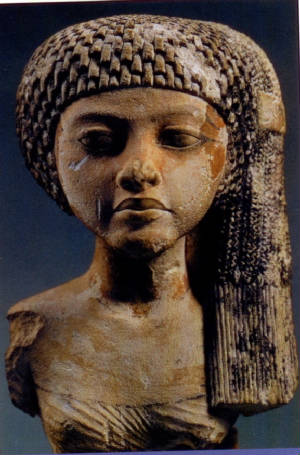|
|
 |
|
Building Akhetaten

Soon after ascending to the throne, Akhenaten (then called Amenhotep
IV) sailed down the Nile River to a place near modern Tel el Amarna. In this spot the sun rose in a gap between the eastern
hills. Akhenaten was inspired to found his new city here, which he called Akhetaten, meaning "the Horizon of the Aten." The
site had no earlier foundations, having no divinity or person who laid claim to it. This was particularly appropriate as a
place representing a completely new beginning.
On the 13th day of the 8th month of Year 5 of his reign, Akhenaten
(having changed his name the previous month) reached the site with his royal retinue and proclaimed the foundation of the
city, announced the buildings to be erected, and decreed a Royal Tomb to be built in the eastern hills for himself, Queen
Nefertiti, and their eldest daughter Meritaten. The city was dedicated to the worship of the Aten, symbol of the sole god
Ra. This was a radical departure from the traditional royal association with the god Amun, and burial in the western hills
in the territory of Amun at Thebes.
Construction proceeded with great haste from Year 6 to Year 8. The buildings had
a new, open style wholly integrated with the worship of the Aten. The temples had no roofs or covered doorways. Statues (such
as those representing a particular deity) were banned. The only approved image of the Aten was the solar disk with emanating
rays. An entirely different art style was developed at Akhetaten; artists were encouraged to portray their subjects more
vividly and realistically. Reliefs depicting the Aten and the royal couple were carved on the walls. The temple was bathed
in light during the day. Flowers were the preferred sacrifice, often accompanied by incense and music.

|
| Meretaten |
In Year 12 Akhenaten received numerous delegations from subject states and surrounding powers asking
for his blessing. This may have marked the death of his father and possible co-regent Amenhotep III. A disagreement with the
Mitannian king over gold-leaf covered statues replacing promised solid-gold statues was a harbinger of great troubles to come.
Conflicts developed with Egypt's subject territories and their neighbors, resulting in war and intrigue. Egypt's army,
accustomed to peacetime construction and domestic administration, may have been ill-equipped to fight foreign wars. Undisciplined
hired mercenaries further complicated matters. The pharaoh seemed unwilling or unable to lead a campaign to subjugate and
defend the territories.
About the Year 14, Akhenaten and Nefertiti's second daughter Meketaten died, perhaps in childbirth.
Close to this time, both Akhenaten's mother Queen Tiye and his wife Queen Nefertiti were no longer mentioned and presumed
dead. Amidst these unfortunate events, Akhenaten died around Year 17 of his reign (c. 1334 BCE) with no official account of
his end.
|
 |
|
"Young god, content with what is Right,
lord of sky, lord of earth, sun-disk, alive, great,
illuminating the two riverbanks, alive, my father,
the living Ra-Horakhty rejoicing in what is Right,
in his name as Shu which is in the sun-disk,
given life for ever and eternity,
sun-disk, alive, great, who is in the sed-festival,
amidst the domain of the sun-disk in Akhetaten;
the living Horus strong bull, beloved of the sun-disk,
he of the Two Goddesses, great in kingship in Akhetaten,
Horus of gold, who raises the name of the sun-disk,
dual king, who lives on what is Right, lord of the two lands,
Neferkheperura sole one of Ra,
son of Ra, who lives on what is Right, lord of sunrisings,
Akhenaten, great in his lifespan,
given life for ever and eternity."
--From a boundary stela at Akhetaten
|
 |
|
|
 |
|
|
 |
|
|
|
|
Ancient Mystery Schools (Part I) Group Project--Akhenaten's Life
|
|
|
 |

